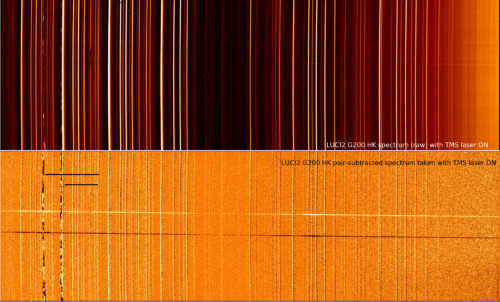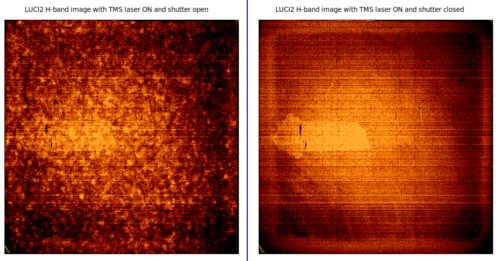Description of TMS
Overview of TMS
The TMS (telescope metrology system) is a laser-truss-based metrology system which maintains the relative position and orientation of the primary mirror and the LBC to within a few microns over slews and over time. TMS has been installed and commissioned for use with the LBCs through a collaborative effort between GMTO, the Wyant College of Optical Sciences at the University of Arizona and the LBTO, with the dual goal of prototyping a TMS for use at the GMT and improving the image quality and efficiency when observing with the LBCs. The system consists of a network of collimators, mounted along the edge of the primary mirror, and retroreflectors, mounted on the LBC hub, which create a truss with 9 collimator-retroreflector pairs, or channels, (3 for redundancy) per side. Laser-interferometric absolute distance measurements along these channels are made every ~30 seconds and used to adjust the position of the primary mirror if the measurements meet certain criteria and the LBC shutter is closed. The 1.5 micron laser does not affect the LBC images.
Unlike the Gregorian instruments, the LBCs do not have off-axis wavefront sensors, and observations must be interrupted to focus and collimate; this procedure can take about 5-10 minutes. TMS reduces the need to re-collimate after each slew or every ~30-40 minutes while tracking. It also enables high-cadence time series which would otherwise be interrupted by the need to re-collimate. The TMS software operates with little user interaction: after focus and collimation, the user will set a reference and then start the measurement loop which runs continuously all night or until stopped to re-focus/re-collimate. While TMS maintains the relative LBC-M1 position and orientation, it cannot correct for aberrations arising from thermal gradients across the primary mirrors (such as low and high order spherical, z11 and z22). It does, however, provide a reference frame for studying these. Currently the system uses data from thermocouples along the surface of M1 to correct for thermal focus (z4), and work is ongoing to correct for other thermally induced aberrations.
The TMS system was installed on the DX side in 2020 and on the SX side in April/May 2021. Since the fall of 2020, it has been used in ‘passive’ mode during LBC observations, making measurements but not adjusting the primary mirror. Since March 2022, TMS has been used in ‘active’ mode on a shared-risk basis during partner science observations with the LBCs.
Laser Truss
TMS uses an Etalon Absolute Mutliline Technology (EAMT) unit [Etalon Absolute Multiline Technology system was produced and distributed by Etalon Ag of Braunschweig, Germany], based on a multi-line Class II 1.5 micron laser, to measure absolute distances to an accuracy of better than 5 microns between a set of 9-10 collimators around the perimeter of the primary mirror and 3 retroreflectors on the LBC hub. The measured distances are corrected for environmental conditions in the chamber using the Ciddor relation [Ciddor, P. E., “Refractive index of air: new equations for the visible and near infrared, Applied Optics, 35 (9), 1566-1573 (1996)] and filtered to remove outliers. The corrected and filtered distances are then used to determine the relative position of the primary mirror to the LBC (the ‘pose’). This is compared to a reference that is typically set after the first collimation of the night, and adjustments are calculated and sent to the primary mirror through the PSF subsystem of the TCS (telescope control system) in order to maintain a fixed pose throughout the night.
A diagram of the laser truss is shown in the figure below (Fig 3-1 of Rakich et al. 2022) for a single side. There are, at most, 9-10 channels between the LBC and the primary mirror, which allows for some redundancy. At minimum, TMS requires 6 channels, with each retroreflector having at least 1 but no more than 3 channels.

Thermal aberrations: The channels between the LBC and primary mirror are used to maintain the pose, but they cannot measure aberrations due to thermal gradients across or through the primary mirror. Initially, the idea was to use the diameter channels as proxies for thermal aberrations, however efforts have now shifted to using the set of measurements from the thermocouples on the front and back surface of the mirror. Already, the average front-to-back temperature difference is being used to predict and correct for thermal defocus (z4), and data collected whenever TMS is used are being analyzed with the goal of modelling all of the low order aberrations (defocus, coma, astigmatism and spherical) induced by thermal gradients on the primary mirror.
EAMT Laser
The TMS uses a commercially available laser-based system to measure absolute distances interferometrically. The Etalon Absolute Mutliline Technology (EAMT) unit provides multiple mono-mode fibers which are capable of measuring absolute distances to within 0.5 ppm in air, giving a resolution of order a few microns in the distance measurements between M1 and the LBC hub, which are of order 10 meters (Rakich+2020).
The class II (<1 mW output power) laser operates at 1532 +/- 70 nm. In alignment mode, the wavelength is fixed, but during operations, it scans the 140 nm around 1532 nm. The maximum power output is < 0.025 mW.
There is also a class II visible red laser which operates at 640 nm and is used only for alignment purposes. It would not be used during observations. Its maximum power output is 10 times higher (< 0.25 mW) but it is also well within the class II category.
Deep spectroscopic and imaging exposures with the MODS and LBCs have been made to insure that the laser is not detected by these instruments. It is detected by LUCI in H band spectra and images, where it gives a mottled appearance to the background, as illustrated by Figures 1a and 1b, below.

Figure 1a: A LUCI G200 HK spectrum taken when the TMS laser was on in measurement/scanning mode. The black arrows point to the two lines produced by the TMS laser at 1.547 and 1.58 microns. In the raw spectrum (top), the lines don’t stand out from the many OH lines, however they have an uneven illumination pattern, something which can be seen better in the pair-subtracted spectrum (below).

Figure 1b: A LUCI H band image taken with the TMS laser on (left side) shows a mottled background as compared to the image taken with the laser on but shuttered so that no laser light is reaching the instrument (right side).
References
More details on the TMS system may be found at the following links:
- SPIE Papers:
- Rakich et al. 2018, Proceedings of the SPIE, Volume 10700, “Prototyping the GMT telescope metrology system on LBT”
- Rakich et al. 2020, Proceedings of the SPIE, Volume 11445, “A laser-truss based optical alignment system on LBT”
- Rodriguez et al. 2020, Proceedings of the SPIE, Volume 11487, “Implementation of a laser-truss based telescope metrology system at the Large Binocular Telescope”
- Rakich et al. 2022, Proceedings of the SPIE, Volume 12182, “Commissioning a laser metrology truss for active optics on the Large Binocular Telescope”
- LBTO staff and those with VPN access may find more detailed information about the TMS system in the LBTO software wiki.

